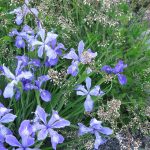A School in Every Garden
The School Garden Project is making vegetables more fun
It looks like the school garden concept is getting some serious respect from the 4J school district. Just look at the spanking new Howard Elementary … Continue reading
We've got issues.
It looks like the school garden concept is getting some serious respect from the 4J school district. Just look at the spanking new Howard Elementary … Continue reading

Don’t miss a golden opportunity to pick up some locally sourced native plants while supporting the efforts of the Friends of Buford Park and Mount … Continue reading

Planning is one of the most important elements of gardening. It is also one of the easiest steps to overlook, especially for the beginner. Knowing … Continue reading
What’s the most cost-effective crop you can grow in a small space? Many commercial growers agree that it’s culinary herbs, and I think this may … Continue reading

Significant rain in early October is a boon to gardeners who value the fall gardening season. This goes in spades for those of us who … Continue reading
August went by in flash, as usual. Daily watering chores. Jam making. An ocean of applesauce. After a week’s vacation in a cabin by the Metolius, I somehow carved out time to think about the fall and winter vegetable garden. Space must be carved out, too, and I’m grateful for any crops that can go in after the pole beans and tomatoes are torn out in October. But starts of red Russian kale, my favorite for winter eating, need to go in as soon as possible. By October what you see is more or less what you get until growth starts up again in March. Continue reading
Not every garden in the Willamette Valley has super river-bottom silty loam. If your soil sets up like concrete when it’s dry it probably holds lots of moisture in the winter. Some wonderful summer blooming perennials have a problem with that. I’m thinking in particular of the many ravishing cultivars of agastache (ag-ah-STAK-ee) and salvia that have hit the market in recent decades. Lots of them need really good drainage to over-winter reliably in our region. Continue reading
A few weeks ago, I ran into Steve Solomon and Marina McShane at the Lane County Farmers Market. This meeting was remarkable for two reasons. One, Solomon, a guru of Northwest vegetable gardening and founder of Territorial Seed Company, has lived in Tasmania since 1998. Two, McShane had recently given me a copy of a book she and Solomon wrote together. Continue reading
A huge proportion of seed production in the U.S. (80 percent-plus) and around the world (40 percent-plus) is controlled by a handful of corporations such as Monsanto and DuPont. Should you care? That depends. Do you like to save your own vegetable seed? How do you feel about giant monopolies, genetic engineering and the idea of plants as intellectual property? Continue reading
Annuals rarely get a mention in books and articles on gardening with native plants. That’s too bad, because a succession of annual species can add a lot of color to your springtime garden, and attract pollinators, too. Flourishing plants of farewell-to-spring (Clarkia amoena) can bloom for many weeks — a happy thing, because it’s one of the showiest natives we have, and an eager self-sower. Mine escaped into a well-watered blueberry patch last year, providing months of gorgeous rose-pink flowers on bushy plants, not to mention abundant seed. Continue reading